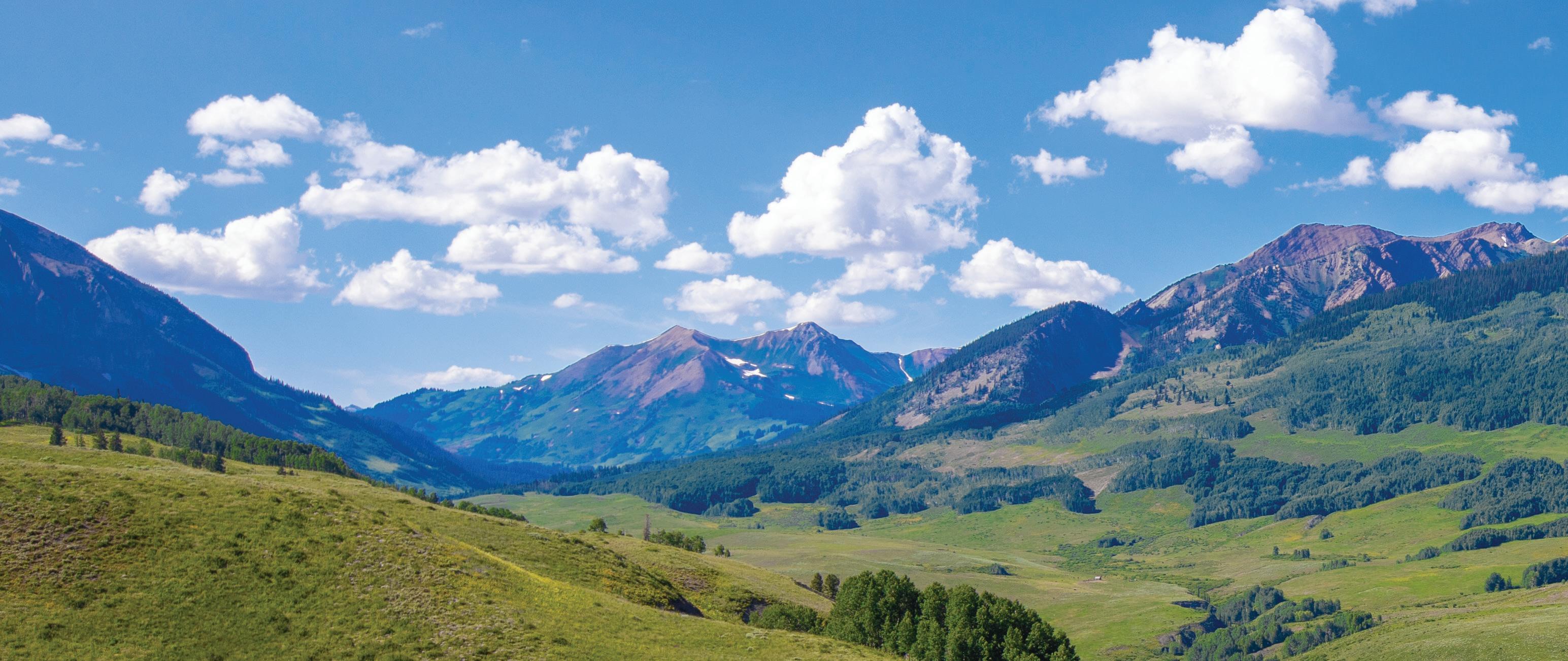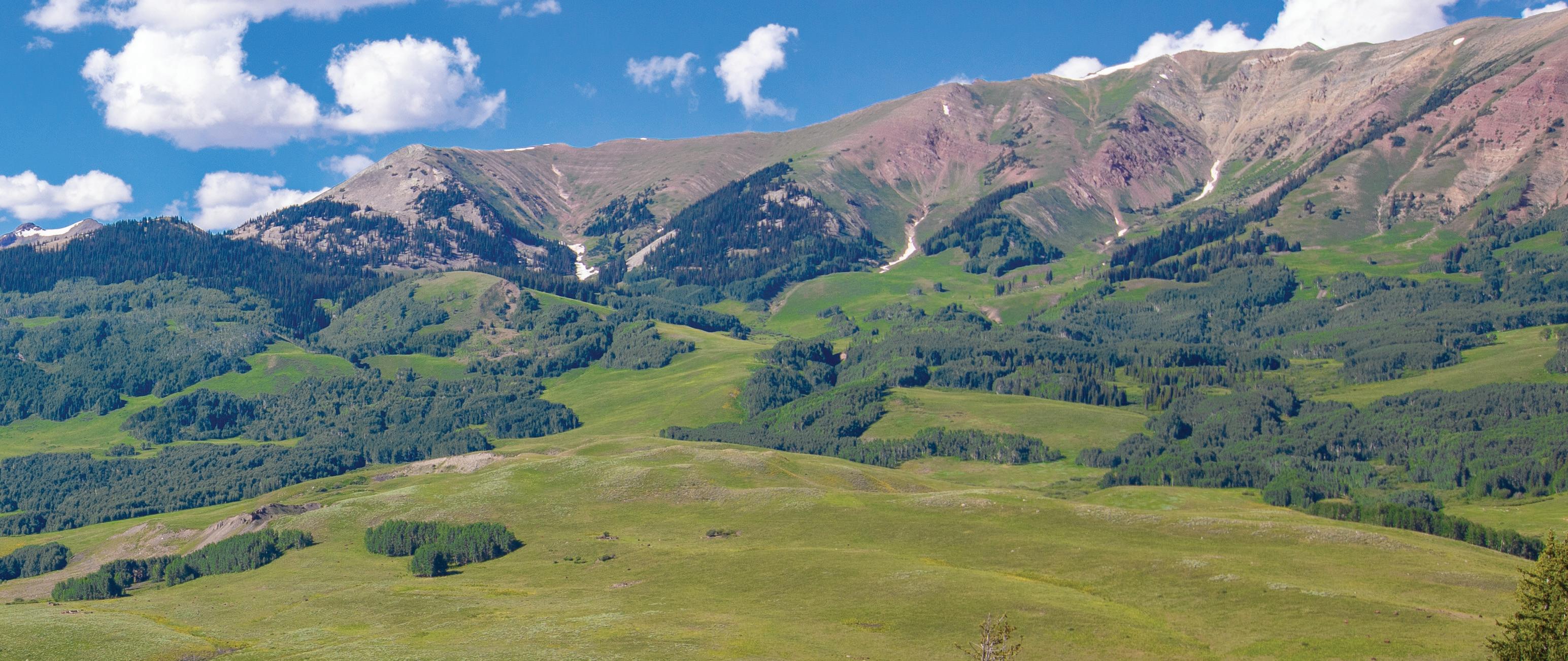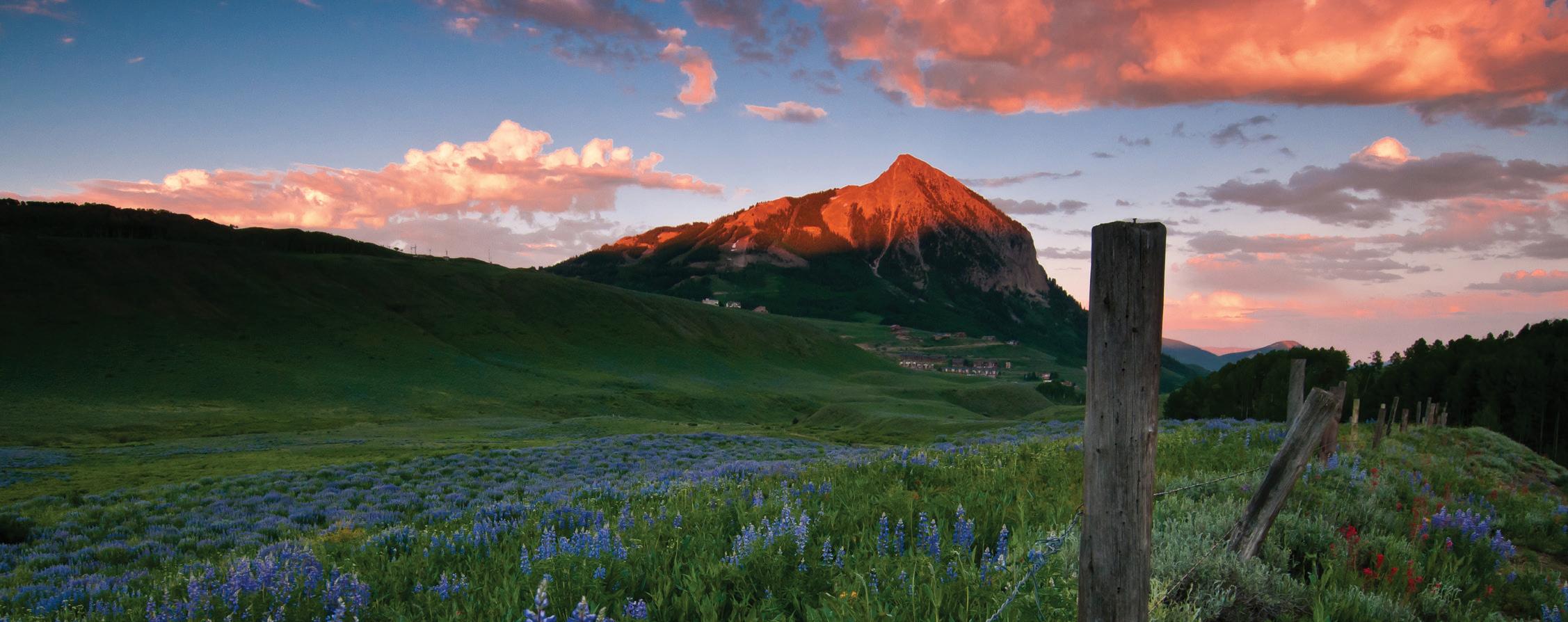
8 minute read
Preserving These Lands
Land Conservation in the Gunnison Valley
By Kendra Walker
Over the years, Crested Butte has drawn people here for many different reasons. From European immigrants coming here to work the mines, to multi-generational ranching families working off the lands, to recreationists enjoying the year-round outdoor opportunities – Crested Butte’s stunning landscape is what inevitably ties us all together. It’s the endless fields dotted with grazing cattle, the hundreds of miles of recreational trails, the precious wetlands and wildlife habitats, the unobstructed views of the surrounding West Elk Mountains – the landscape is the focal piece of what makes this place so special.
“Crested Butte still looks like it did the day I moved here 30 years ago,” says LIV Sotheby’s agent Channing Boucher. “Because this place is preserved and conserved is why Crested Butte looks the way it does today. Because of land conservation, it keeps all of these open spaces open for all of us to enjoy.”
Crested Butte’s majestic landscape has inspired and instilled a strong community-driven culture of land conservation. Led by various groups with diverse interests ranging from trail creation and stewardship, habitat protection, and ranching advocacy, the goal is the same: to protect and preserve the lands of the Gunnison Valley.
One such group is the Crested Butte Land Trust, a local non-profit that has been protecting and stewarding the Crested Butte landscape for 30 years. Serving as a community ambassador for open space, the Land Trust has helped protect nearly 6,000 acres of land in the Gunnison Valley through land purchases, establishing conservation easements with landowners, and continuous stewardship management. Some of Crested Butte’s most beloved trails and wetlands, including Long Lake and the Lower Loop trails system of the Slate River Valley, are protected thanks to the Land Trust and its collaboration with donors, local partners, and landowners.
“Personally I’ve always been very connected to the land that has been conserved and protected through the Land Trust,” says Crested Butte Land Trust executive director Jake Jones. “I love the environment here in Crested Butte as much as I did when I moved here so many years ago. The Land Trust and the community have been very successful in protecting scenic vistas and recreational opportunities, and so much has been facilitated in partnership with a lot of other stakeholders. I’m proud of that and we will continue with those efforts.”
“When I first came to Crested Butte and what attracted me was all of the open space and the beauty of Crested Butte itself,” says LIV Sotheby’s agent Kiley Flint, who serves on the Land Trust board. “Being affiliated with the Land Trust is something that’s been very important to me in giving back to the community and to protect what Crested Butte is all about; from the ranching heritage, the recreation, the wildlife, these vistas, everything. That foresight this community had to be able to protect our valley is huge and it’s important to value that.”
The Trust for Public Land, a national non-profit organization, has also been involved in many of the key conservation projects in the valley, including Town Ranch Park, Kochevar open space that includes the Lupine Trails, and much of the scenic ranchlands along Highway 135 between Gunnison and Crested Butte. The Trust for Public Land works on a full range of conservation and outdoor recreation-based land transactions, working with communities to create dedicated public funding for open space, parks, and trails. In total, it has permanently conserved nearly 8,500 acres in the Gunnison Valley.

“None of this happens by itself. Everything we do is achieved through collaboration with partners, from the U.S. Forest Service, Gunnison County, the City of Gunnison, the Town of Crested Butte, the Bureau of Reclamation, Colorado Parks and Wildlife, and the National Park Service,” says Colorado & Southwest Region director Jim Petterson. “Collaboration is the hallmark of the Gunnison Valley.”
While The Trust for Public Land does not hold conservation easements itself, it works with partners to help make those land protections happen. The Trust also worked with Crested Butte to put forward a sales tax for town parks and trails which, according to Petterson, generates about a half million in funding each year.
“The Gunnison Valley is one of our priority areas because it is such a special place,” says Petterson. “And what’s great about our work here is it’s so broad. It’s still an intact, opportunity-rich valley with a healthy mix and ranching, residential, and recreation. I believe the Gunnison Valley is truly unique in that way - having a mix of the ski mountain while still having a strong and vibrant ranching community that provides an enormous scene of open space. It took a lot of players to make it happen to keep it that way.”
The Gunnison Ranchland Conservation Legacy was created in 1995 to establish support for conservation efforts in the ranching community of the Gunnison Valley. Like The Trust for Public Land, Legacy does not hold easements but rather serves as a project manager to facilitate conservation easements between ranchers and land trusts. “We act as a landowner advocate in the conservation process. We support and protect the agricultural use of these lands,” says Legacy executive director Stacy McPhail.
Legacy has helped protect more than 50,000 acres of ranchland in the Gunnison Basin, about 48,000 of that being in sage grouse habitat. “Almost 50 percent of the private agricultural land in the Gunnison Basin is under permanent easement,” says McPhail. “And we’re getting more interest now more than ever.”
“Our primary goal is ranchland. In addition to the ranching legacy, the scenic beauty it creates is beyond compare. When you’re going down the highway here, you look up and see BLM or National Forest land, but the bottom half of that view is ranchland,” says LIV Sotheby’s broker Cathy Benson, who sits on Legacy’s board. “This is an amazing and unique group of people. We continue to keep open space in the valley, which most resort valleys don’t have. It makes us unique.”
While Legacy focuses specifically on ranchlands in the valley, McPhail is grateful the community has the full spectrum of land conservation efforts. “We have a lot of conserved space as a result. I’m proud that we have such a concerted effort across a wide array of groups working toward that goal between public and private land,” she says. “That’s a crucial part of the health of our landscape. That’s what makes it unique. These partnerships were purposeful and meaningful. Our community decided to do something proactive about land conservation. It doesn’t matter if you’re a recreationist or a rancher, most people have a compelling pull to protect it.”
But it’s not just up to these organizations to conserve our lands, it takes the entire community – locals, part-time residents, and visitors - to treat this beautiful valley with respect. It’s not just about investing in the properties here, it’s about investing in the community and the surrounding landscape to ensure it stays vibrant into the future. Otherwise the very thing that attracted us here in the first place will disappear altogether.
With significant increases in trail use and backcountry access in the Crested Butte area in recent years, it’s more important than ever that people follow Leave No Trace principles and backcountry etiquette. Respect for our lands is critical, as many of the trails we access cross over conservation easements and private conserved property. And as U.S. Forest Service and Bureau of Land Management areas continue to grow in popularity for recreation and camping, it’s imperative that we work together to keep open space open for generations to come.
“We ask folks to be more mindful of their impacts and their surroundings than ever before,” says Jones. “By practicing attentive trail stewardship, you’re helping us to not only mitigate the increased recreational use we anticipate this summer, but also to help us fulfill our mission in protecting our conserved lands for future generations.”
This summer, LIV Sotheby’s has sponsored a public outdoor toilet at Lake Irwin, on behalf of the Adaptive Sports Center, to help with trailhead waste management. “I’m a huge supporter of land conservation. These sponsorships organized through the Chamber of Commerce ensure that the porta potties in the backcountry will be maintained, cleaned, and useful for the public,” says LIV Sotheby’s agent Gary Huresky.
Huresky also supports the Crested Butte Mountain Bike Association and the Crested Butte Conservation Corps (CBCC), who advocate for a sustainable recreation landscape through building, maintaining, and stewarding trails. During the summer, the CBCC crew is in the field seven days a week maintaining trails, picking up trash, and educating recreation users. On average each year, the CBCC removes 1,164 pounds of trash from trails and the backcountry.
I appreciate what the Conservation Corps is doing,” says LIV Sotheby’s agent Jill Matlock. “So many people are hitting our trailheads. There needs to be management in the backcountry and it’s critical that we all work together to educate people how to enjoy this place responsibly.”
LIV Sotheby’s agent Betsy Wiebe agrees that education goes a long way. “It’s so important to educate ourselves and others about conserving the area and conserving it respectfully,” she says. “This place is for all of us. We’re all sharing this beautiful place that we get to enjoy.” •
To learn more about and to support land conservation in the Gunnison Valley, visit: cblandtrust.org, gunnisonlegacy.org, and tpl.org
To learn more about best practices while out on trails, conserved lands, and backcountry, visit: crestedbuttemountainbike.com/trail-information/etiquette, crestedbuttemountainbike.com/camping, and travelcrestedbutte.com/mountainmanners






